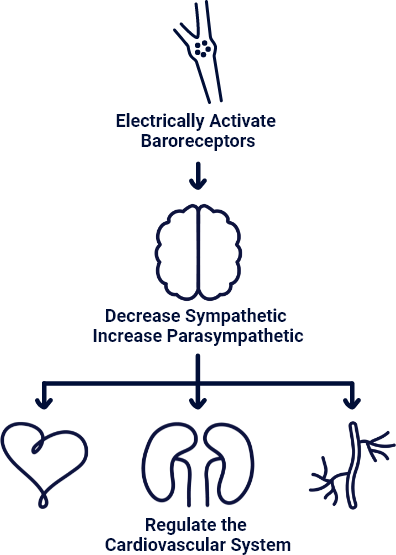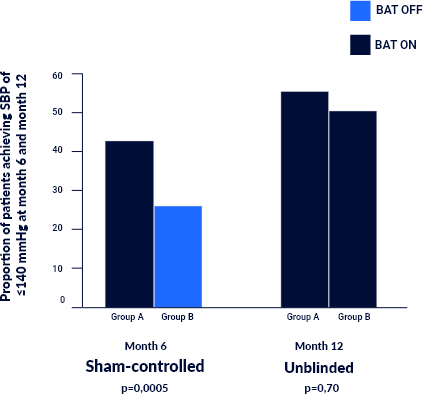A better way to treat resistant hypertension
Uncontrolled resistant hypertension doubles cardiovascular risk
Resistant hypertensive patients run a 50% higher risk of Myocardial Infarction (MI), Stroke, Chronic Heart Failure (CHF) or Chronic Kidney Disease (CKD)1, 2


Baroreflex Activation Therapy restores autonomic balance
Baroreflex Activation Therapy (BAT™) reduces blood pressure in resistant hypertension patients through activating carotid baroreceptors, signaling the brain to decrease sympathetic and increase parasympathetic activity to the cardiovascular system5
Demonstrated mechanism of action

Barostim significantly reduces blood pressure (BP), helping the majority of patients reach their systolic blood pressure goal7*

*Over half (55%) of patients in the pivotal trial achieved goal SBP of ≤140 mmHg

Proven to sustain blood pressure reductions, for 6 years and counting…8

Projected to decrease overall rate of major cardiovascular (CV) events9

References
- Chobanian AV et al. The Seventh Report of the Joint National Committee on Prevention, Detection, Evaluation, and Treatment of High Blood Pressure: The JNC 7 Report. JAMA. 2003;289:2560-2572.
- Kaplan NM. Resistant hypertension. J Hypertens. 2005 Aug;23(8):1441-4.
- Pimenta E and Calhoun D. Resistant Hypertension: Incidence, Prevalence and Prognosis Circulation. 2012 April 3; 125(13): 1594–1596.
- Daugherty SL et al. MD Incidence and Prognosis of Resistant Hypertension in Hypertensive Patients Circulation. 2012 April 3; 125(13): 1635–1642.
- BAROSTIM NEO System™ reference guide. Available at https://www.cvrx.com/wp-content/uploads/2022/09/Reimbursement-and-Clinic-Reference-Guide_pages.pdf – Last accessed March 2016
- Heusser K, Tank J, Engeli S, Diedrich A, Menne J, Eckert S, et al. Carotid Baroreceptor Stimulation, Sympathetic Activity, Baroreflex Function, and Blood Pressure in Hypertensive Patients. Hypertension. 2010; 55(3):619-626.
- Bisognano JD et al. Baroreflex activation therapy lowers blood pressure in patients with resistant hypertension: results from the double-blind, randomized, placebo-controlled Rheos pivotal trial JACC 2011; 58(7):765-73
- De Leeuw PW et al. Baroreceptor activation therapy in treatment-resistant hypertension: six years follow-up data. Presentation, ESH, Milan 2015
- Borisenko O et al. Cost-effectiveness of BAROSTIM THERAPY™ for the treatment of resistant hypertension in European settings. Journal of Hypertension 2014, 32:681–692
